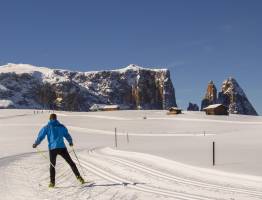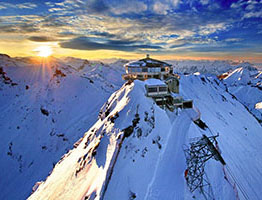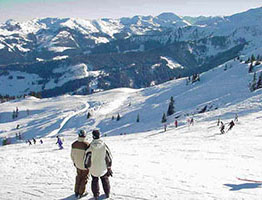How mountain flora survives under the white blanket
In the summer, hikers and mountain bikers enjoy the beautiful Alpine nature. The flowers and plants are beautiful and give the mountains their fairytale appearance. In winter there is mainly skiing and snowboarding and no one thinks about the hidden nature under the snow. The snow is above all very entertaining, but also essential for some plants to survive in the harsh mountain climate. The white blanket contributes to the fairytale appearance in the summer. Curious about how that works? Then please read on.
Plants survive through their own specialisms
The plants that grow in the mountains have had to adapt to a harsh climate. The conditions can be very different and each place attracts its own plants. The higher you go, the more difficult it becomes for plants and trees to thrive. At the top, the temperature is lower, the growing season is very short because of the snow, the wind is stronger and there is less oxygen. For that reason, above a certain limit you no longer see trees, because they cannot survive there. Above the tree line in the Alps, the vegetation changes into bushes and eventually into increasingly smaller plants. At very high altitudes, only lichens are found, which are real survival artists.
In the mountains, you will find very varied substrates; rocky soil that retains little water, damp marshes, forest soil and grassy meadows, all of which attract their own flora with their own specialisms. That alone makes nature in the Alps very special.
The insulating effect of snow
Newly fallen snow is very airy. This is due to the shape of the loose snow crystals, which are all hexagonal. Did you know that every snow crystal is unique? No two are the same. Due to the shape of the crystals, which have many protrusions, they fall loosely on top of each other, which means that air remains between them. Powder snow even consists of 95% air. As the layer becomes thicker, the protruding parts break off and the snow becomes more compact, but as long as it does not become a layer of ice, air remains between them.
Air is a good insulator. It has a low thermal conductivity, which means that the air inside the snow has difficulty dissipating heat. As a result, the heat from the ground is not lost to the air above the snow and the cold from above does not penetrate to the ground. If the outside temperature is -20°C, it is still 1.6°C under 50 cm of snow. As a result, the ground under the snow will not freeze quickly.
Sunny southern slopes for a longer flowering period
More than half of the year, there is snow in the mountains. At 1000 metres above sea level, this is about 3 to 4 months in a normal winter, with maximum snow depths of 2 metres, but at 2000 metres this is already 6 to 7 months with snow depths of up to 5 metres. This is a long period, during which the growth and flowering of plants largely comes to a standstill. Flowering plants need a minimum snow-free period of two months to be able to flower and reproduce. The southern slopes that catch a lot of sun are therefore ideal for these plants. The snow melts here first and therefore ensures a longer period for flowering.
Frost-sensitive plants opt for a longer snow period
The disadvantage of the sunny southern slopes is that if spring is warm early and a frost period suddenly follows, the insulating layer of snow has already disappeared. Plants that are vulnerable to freezing, such as the alpenrose, are therefore unlikely to be found here. Frost-sensitive plants prefer north-facing slopes, eroded hollows or small ditches and moraine fields, where the sun has difficulty reaching and the snow therefore remains longer. A disadvantage is that the growth and flowering period is therefore shorter. If you pay close attention, you will see that you often see the well-known alpenroses in such places. They have frost-sensitive, evergreen leaves and originally come from the moist and mild mountain forests of China. There, frost is rare in the spring and so the plants have not had to adapt to it.
Other plants that try to avoid frost are the bilberry (Vaccinium myrtillus), the bog bilberry (Vaccinium uliginosum), the lingonberry (Vaccinium vitis-idaea) and the crowberry (Empetrum). These heather-like plants choose semi-shade with sufficient shelter though the snow, but in order to be able to grow and bear fruit, they should not lie under the white blanket for longer than 5 to 6 months. They grow between 1900 and 2400 metres above sea level and can produce delicious berries.
A flower at high altitude
Some plants do not wait for the snow to disappear. Flowering and thus ensuring that they can multiply is a very important task, but when you are high up in the mountains you have very little time for that. The small tassel flower (Soldanella pusilla) lives at an altitude of 3100 metres and therefore has an extremely short growth period. For that reason, it already starts preparing under the snow. It can use the energy of the sun, up to 20 cm under the snow, to grow and prepare itself for flowering. This flower is also known for sticking its flower head above the snow layer, even before it has completely disappeared. That is why this plant is also called the ice bell.
Snow in the Alps is therefore not only fun, but also very useful for the Alpine flora. Due to its insulating effect, it ensures that especially the vulnerable plants can survive in the winter and can rightly be called a white 'blanket'. This allows us to enjoy all the beautiful blooming flowers in the summer. So if you are on a winter sports holiday in the Alps, think about the flowers and plants that live well protected under your feet during the descent.
Do you want to know more about nature in the Alps? Then read our article about Spring in the Alps or about the Alpine ibex.







